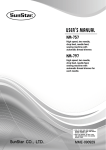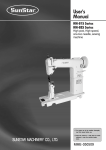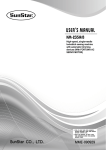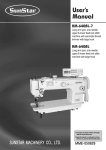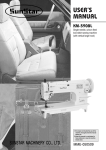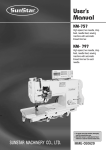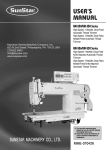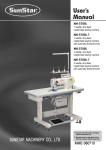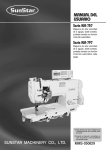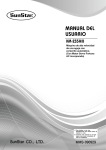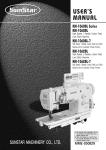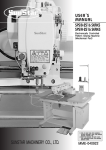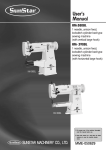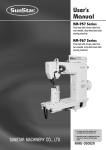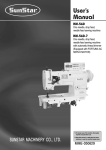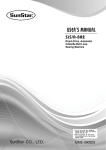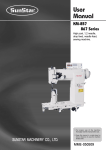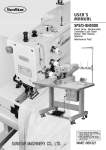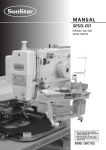Download SUNSTAR MACHINERY CO., LTD.
Transcript
USER ’ S MANUAL KM-591BL-7 Long Arm Type, 1 Needle, UnisonFeed Lock Stitch Machine With Vertical Large Hook and an Automatic Thread Trimmer KM-591BL Long Arm Type, 1 Needle, UnisonFeed Lock Stitch Machine with Vertical Large Hook SUNSTAR MACHINERY CO., LTD. 1) FOR AT MOST USE WITH EASINESS, PLEASE CERTAINLY READ THIS MANUAL BEFORE STARTING USE. 2) KEEP THIS MANUAL IN SAFE PLACE FOR REFERENCE WHEN THE MACHINE BREAKS DOWN. MME-050509 lity a u tQ Besst Pricevice Be st Ser Be 1. Thank you for purchasing our product. Based on the rich expertise and experience accumulated in industrial sewing machine production, SUNSTAR will manufacture industrial sewing machines, which deliver more diverse functions, high performance, powerful operation, enhanced durability, and more sophisticated design to meet a number of user’s needs. 2. Please read this user’s manual thoroughly before using the machine. Make sure to properly use the machine to enjoy its full performance. 3. The specifications of the machine are subject to change, aimed to enhance product performance, without prior notice. 4. This product is designed, manufactured, and sold as an industrial sewing machine. It should not be used for other than industrial purpose. R SUNSTAR MACHINERY CO., LTD. Contents Safety Regulations for Machines ································4 1. Specifications 1) Sewing machine specifications 8 2) Motor specifications 9 2. Installation 1) Installation of the machine head 10 2) Installation of power switch box 10 3) Oil supply 11 4) Belt tension adjustment 11 5) Installation of program unit 12 6) Installation of belt cover 12 7) Installation of thread stand 12 8) Installation of knee lifting pad 13 9) Installation of air pressure related parts and checking their functions (optional) 13 3. Adjustment of sewing machine 1) Needle insertion 14 2) Needle Bar adjustment 14 3) Regulating timing of needle and hook 14 4) Regulating oil supply to hooks 15 5) Lower thread winding and adjustment 15 6) Lower thread hanging and tension adjustment 16 7) Upper thread hanging 16 8) Thread tension adjustment 17 9) Presser foot pressure adjustment 18 10) Stitch length adjustment 18 11) Adjustment of feed dog height and inclination 19 12) Adjustment of main and auxiliary presser foot 19 13) Adjustment of main presser foot movement 20 14) Feed cam adjustment 21 15) Adjustment of reverse solenoid location 21 16) Adjustment of trimming device 21 17) Adjustment of mes pressure 23 18) Changing moving mes 23 19) Changing fixed mes 23 20) Appropriate speed for stitches lengths 24 21) Automatic presser foot lifting device (optional) 24 Safety Regulations for Machines Safety Regulations for Machines The safety marks are defined as danger, warning and caution. In case the regulations are not followed, it will bring about physical injuries or mechanical damage. The safety marks and symbols are as follows. [Meaning of Safety Sign] Danger The contents of this mark should be observed clearly. Or users are apt to be killed or suffer severe physical injuries. Warning The content of this mark should also be observed, otherwise users are likely to die or suffer severe physical injuries. Caution The content of this mark should also be observed, otherwise it will bring about the physical injuries or the mechanical damage. [Meaning of Marks] This mark means a 'must-not.' This mark means a 'must' for safety. This mark should be observed, or users are likely to be struck by electricity. 4 1-1) Machine Transportation Danger 1-2) Machine Installation Caution The person who knows the safety regulations well should transport machines. In case the machines are transported, the following directions should be observed. ⓐ At least 2 persons should work together. ⓑ In case the machine should be transported, please wipe the oil covered on the machine to prevent the accident. Because the physical damage such as the functional obstacles and breakdowns are likely to occur in compliance with the condition of installing the machine, the following preconditions should be fulfilled. ⓐ Please keep the order from top to bottom when unpacking the package. Especially, mind that the nail on the boxes. ⓑ Because machines are apt to be contaminated and corroded by dust and moisture, you should install the climate controller and should clean the machines regularly. ⓒ Keep the machines out of the direct rays of the sun. ⓓ Keep both sides and the backside of the machines off at least 50cm from the wall to secure enough space to repair. ⓔ Don't run the machine near the places with the dangers of explosion. Don't run the machine near the places with the dangers of explosion, including the places where the spraying product like aerosol are used in large quantities or oxygen are dealt with, unless the exact actions concerning the operation are guaranteed to avoid the explosion. ⓕ Because of the peculiarity of the machine, any illuminators are not equipped. So, users should install the lighting apparatus around the working area. [Note] The details about the installment of the machine are described in No. 2 Installment of Machine. 1-3) Troubleshooting Danger In need of troubleshooting, it should be done by the trained A/S engineer of our company. ⓐ Ahead of cleaning and repair, be sure to shut off the power supply. And wait for about 4 minutes till the machine discharges completely. ⓑ Even a part or all of the machine should not be modified without any consultation with our company. ⓒ In case of repair, you should change the damaged part into the standard article of our company. ⓓ After repair, please put again the safety cover disjointed while repairing. 5 1-4) Machine Operation Warning KM-591BL series are manufactured for industry use to sew textiles and other similar material. In case of running the machine, users should observe the following things. ⓐ Ahead of operating the machine, please read the manual and understand fully the details on its operation. ⓑ Don't forget to put on the garment suited for the safe work. ⓒ Keep your hands or a part of the body away from the running part of the machine like a needle, hook, thread take-up spring and pulley etc. ⓓ Don't remove any kind of cover for safety while running the machine. ⓔ Be sure to connect the earthed line. ⓕ Before opening the electric box such as a control box, be sure to shut off the power supply and make sure that the power switch should be put on "off." ⓖ When threading the needle or before checking after sewing, be sure to stop the machine. ⓗ Don't switch on the power supply with the foot on the pedal. ⓘ Don't run the machine when the cooling fan are not running. Be sure to clean the air filter in the control box once a week. ⓙ If possible, keep off from the strong electronic wave like a high frequency welding machine. Warning 1-5) Safety Device Warning Fingers or hands can be cut off because of the belt. So be sure to run the machine after covering the safety cover, and in case of checking or regulating, be sure to switch off the power supply. ⓐ Safety Label : Suggestions while running the machine are stated ⓑ Thread take-up lever cover : The device to prevent the human body from touching the thread take-up lever ⓒ Belt cover : The device to prevent hands, feet and clothing from getting jammed by the belt ⓓ Finger guard : The device to prevent fingers from contacting the needle ⓐ ⓑ ⓒ ⓓ 6 1-6) Precaution Mark Position CAUTION 경 고 "Precautions" is adhered to the machine for safety. In case of starting to run the machine, read the directions of "Precautions" carefully. [Position of Precaution Mark] Do not operate without finger guard and safety devices. Before threading, changing bobbin and needle, cleaning etc. switch off main switch. 손가락 보호대와 안전장치 없이 작동하지 마십시오. 실, 보빈, 바늘교환시나 청소전에는 반드시 주 전원의 스위치를 꺼 주십시오. CAUTION 경 고 Hazardous voltage will cause injury. Be sure to wait at least 360 seconds before opening this cover after turn off main switch and unplug a power cord. 고압 전류에 의해 감전될 수 있으므로 커버를 열 때는 전원을 내리고 전원 플러그를 뽑고 나 서 360초간 기다린 후 여십시오. 1-7) Content of Precaution CAUTION 경 고 Notice Do not operate without finger guard and safety devices. Before threading, changing bobbin and needle, cleaning etc. switch off main switch. 손가락 보호대와 안전장치 없이 작동하지 마 십시오. 실, 보빈, 바늘교환시나 청소전에는 반드시 주전원의 스위치를 꺼 주십시오. CAUTION 경 고 Hazardous voltage will cause injury. Be sure to wait at least 360 seconds before opening this cover after turn off main switch and unplug a power cord. 고압 전류에 의해 감전될 수 있으므로 커버 를 열 때는 전원을 내리고 전원 플러그를 뽑 고 나서 360초간 기다린 후 여십시오. 7 1 Specifications 1) Sewing machine specification KM-591BL-7 Long arm type, 1-needle unison feed lock stitch machine with vertical large hook and an automatic thread trimmer KM-591BL Long arm type, 1-needle unison feed lock stitch machine with vertical large hook. Model name Item Trimming device KM-591BL ★ Climb device ★ Use Medium to heavy weight material Sewing speed Max. 2,400 spm Maximum stitch length 9 mm Needle bar stroke 35 mm Thread take-up lever stroke 71.5 mm Hook Vertical large hook Needle DPX17 #16~23 (Standard #23) Lift of the presser foot (by hand) 9mm, / (by knee) 16mm Alternating vertical movement 2~5.5 mm Compressed air 8 KM-591BL-7 0.5 Lubrication Automatic oil supply Working space 322 mm 2) Motor specifications (1) Servo motor specifications MODEL VOLT WATT HERTZ S3M55-1B Single Phase 110V 550W 50/60 Hz S3M55-2B Single Phase 220V 550W 50/60 Hz S3M55-3B Three Phase 110V 550W 50/60 Hz MODEL VOLT WATT HERTZ HEC-1705 (Single Phase) 110V/220V 400W 50/60 Hz HEC-1706 (Triple Phase) 110V/220V 400W 50/60 Hz (2) Clutch motor specifications (3) Peripheral automatic device (optional) specifications Name of optional devices Model Auto Knee Lifting System Usage Air pressure cylinder working structure where the presser foot is automatically lifted by one backward pedal. Production Counter SCOUN-1 A production counting system where the completed amount is displayed in the program unit panel. Addition, subtraction and amended inventory are also displayed in addition to implementation ratio. Material Edge Sensor SEDG-1 SEDG-2 By detecting the fabric s edge or thickness, the machine automatically stops without halting the pedal. The two types of sensors are edge sensor type SEDG-1 and the thickness sensor type SEDG-2. Standing Pedal SPDL-1 SPDL-2 This is an indispensable device when one man operates a number of machines. Separate pedals for acceleration, thread trimming, and presser foot lifting are set up. There are the fixed speed SPDL-1, EDPL-1 and the variable speed SPDL-2, EDPL-2. 9 2 Installation Warning ▶ In case of installing the machine, it should be performed by the trained engineer. ▶ In case of wiring work, be sure to leave the work to an expert or an agent. ▶ The machine weight over 43kg. At least 2 persons should carry out the installing work. ▶ Plug in after finishing the installing work. In case the user press on the step by mistake, the machine runs automatically. By doing so, it can cause the physical injuries. ▶ Connect the earthed lines. Imperfection of the connection of the earthed lines gives rise to an electric shock or malfunction. ▶ Set the belt cover on top of the machine. ▶ In case of bending the machine backward or returning to the original condition, be sure to use both hands. If you use only one hand, it causes physical injuries by slipping. 1) Installation of the machine head Insert hinge rubber into the table. As described in Figure 1 , put the oil pan corner in the middle of the head supporting rubber and attach the table. After putting the hinge in the bed hole, insert the hinge rubber and install the sewing machine in the table corner rubber cushion. ①③ ② ② (Fig. 1) 2) Installation of power switch box When attaching the power switch box , as shown in Figure 2 , attach it to lower right corner of the table. (Fig. 2) 10 Caution ▶ Be sure to plug in after finishing oil supply. If the user press on the step by mistake, the machine runs automatically. By doing so, it can cause the physical injuries. ▶ In case of treating the lubricant, don't bring the lubricant into contact with eyes or the skin. Its contact can cause an inflammation. And don't drink the lubricant. It can cause vomiting or diarrhea. And Keep it out of the reach of the children. ▶ Be sure to run the machine after supplying oil in case you should start to run it for the first time, or in case it has not been used for a long time. 3) Oil supply (1) Fitting the magnet to remove chips (iron powder). Find the magnet to remove chips in the accessory box and it to the oil pump located at the lower part of the bed as shown in Figure 3 . Do not use the magnet for other purposes. Operating the sewing machine without the magnets may cause malfunction and adverse effects to its durability. (2) Filling the oil pan with lubricants A. Fill the lubricant up to the H" point . B. You should use the exclusive oil provided by SUNSTAR" for industrial sewing machines or TELLUS C10" of the Shell company. C. If the oil lever drops to the L" level , replenish it to the H" point . D. Change the lubricant once every two weeks. Magnet ① ② Oil pump (Fig. 3) (Fig. 4) 4) Belt tension adjustment After installing the motor, if you sufficiently loosen the fixed nuts and , tension in the belt will occur naturally because of the weight of the motor . At this moment, tighten the fixed nut and use fixed nut to fix it firmly. (See figure 5) (Fig. 5) 11 5) Installation of program unit(Sever Motor) A. Use 4 fixed screws to fix the bracket on the program unit In the program unit , use two fixed bolts to tightly fix the assembled brackets. (Fig. 6) 6) Installation of belt cover A. 3 screws that support the belt cover can be found in the accessory box. Assemble the two short screws into the upper part of the sewing machine, and assemble the remaining and longest screw into the lower part of the sewing machine. B. Fix the Belt cover A” into the belt cover supporting screw and assemble it using the belt cover fixed screw (See figure 7). C. Insert the front part of "belt cover B" into the groove of the front part of Belt cover A" , and use the fixed screw to fix the back part. (See figure 7) (Fig. 7) 7) Installation of thread stand As shown in Figure 8 , assemble the thread stand , insert it in the table hole, and use the fixed nut and washer to fix it. ② ① ③ (Fig. 8) 12 8) Installation of knee lifting pad A. The knee lifting pad(ass’y) socket wrapped in the accessory box must be placed in the knee lifting axis ③ ② B. Loosen bolt tighten it. and maintain knee-lifting pad in vertical position to ① [ Caution ] When reclining the machine, recline after removing the kneelifting pad(ass’y). (Fig. 9) 9) Installation of air pressure related parts and checking their functions (optional) Caution ▶In need of regulating the machine with the switch on or with the air injected, please pay special attention to your safety. ▶Please adjust air pressure to 0.5Mpa. (1) Installation As shown in the figure, after fixing the air pressure filter on the bracket, use the neck screw to fix the bracket on the lower side of the table. ② (2) Air pressure adjustment a) Adjust the pressure by taking out and lifting the air pressure filter knob . b) After adjusting the air pressure to. 0.49 (5 f/ ) turn the knob to its original position and the adjustment is over. ① (Fig. 10) 13 3 Adjustment of sewing machine Caution ▶In case of setting the needle, be sure to switch off the power supply. In case the user press on the step by mistake, the machine runs automatically. By doing so, it can cause the physical injuries. ▶In case of using the clutch motor, the motor revolves because of inertia for a while even after switching off the power supply. Be sure to start to work only after the motor comes to a complete stop. 1) Needle insertion While the needle groove is on the left, adhere the needle tip on the upper side of the stopper hole and fix the needle with the fixing screw (See figure 11) . (Fig. 11) 2) Needle bar adjustments After opening the side plate, turn the pulley and place the needle bar at the lowest point, loosen the needle plate tightening screw and move the needle plate frame at the bottom, after aligning the needle plate s lowest point marked seal , firmly tighten the needle bar tightening screw . (See figure 12) (Fig. 12) 3) Regulating timing of needle and hook After adjusting the needle bar and elevating the needle bar lowest point by 2.2mm, place the hook point at the center of the needle and fix and tighten the setting screw . At this moment, the distance between the needle and hook point should be 0.02mm~0.05mm and the needle plate seal point and needle bar frame should align with the lower side. (See figure 13) 0.02~0.05mm 2mm 2.2mm (Fig. 13) 14 4) Regulating oil supply to hooks Caution ▶ In case of checking the amount of oil to hooks, please take care lest the hands or the checking slip of the amount of oil should come into contact with the movable parts such as the surrounding tools for transfer. Its contact can cause injuries. Hook (1) Checking oil supply amount Oil check paper Spread oil band Oil pan Spread oil band About 0.5 mm About 1 mm Minimum Maximum optimum amount optimum amount ① Decreased If you turn the oil supply adjustment screw assembled at the lower axis front bushing clockwise (+) the supply of oil will increase, and if it is turned counterclockwise(-), it will decrease. Increased (2) Oil supply adjustment Bed 3~10mm A. After the sewing machine runs 3 minutes of empty rotations(at a proper speed) if you put the oil supply check paper as shown in Figure 14 and run the machine for 5 seconds, you can check the quantity of oil by the amount of oil that appears on the oil supply checking paper. B. The oil checking should be done three times and the appropriate maximum and minimum quantity are shown in Figure 14 . (If the oil supply is too small, the hook can have motor problems, and if the oil supply is too big, the fabric can be contaminated by the oil.) (Fig. 14) 5) Lower thread winding and adjustment (1) Winding the lower thread A. The thread should come out through hole from the back of the tension regulating dish towards the front. B. The thread should be taken to the bobbin and wound clockwise 5 or 6times from the bottom. C. After pushing lever and letting pulley touch the V-belt, run the machine. D. If the bobbin winds all the lower thread, pulley is automatically separated from the V-belt. (See figure 15) (2) Lower thread adjustment A. When the lower thread is wound irregularly unscrew , move it left to right, and tightly screw again. B. The lower thread's winding amount can be adjusted. if you turn the regulating screw clockwise it increases and if you turn it counterclockwise it decreases. C. For the lower thread's tension adjustment that winds the bobbin, if you turn screw clockwise it becomes stronger and if you turn it counterclockwise it becomes weaker. (Fig. 15) 15 Caution ▶In case of adjusting the tension of the lower thread, be sure to switch off the power supply. If the users press on the step by mistake, the machine runs automatically. By doing so, it can cause the physical injuries. ▶In case of using the clutch motor, the motor revolves because of inertia for a while even after switching off the power supply. 6) Lower thread hanging and tension adjustment Weak Strong (Fig. 16) A. After putting the bobbin case into bobbin , hang the thread between the thread groove and under the tension adjustment pan spring . For the lower thread tension adjustment, turn the tension adjustment screw clockwise to make it stronger and turn it counterclockwise to make it weaker. For the lower thread output tension, hold the thread end so that when the bobbin case is dropped it can drop gradually by its own weight.(See figure 16) B. Removing bobbin case Hold the bobbin case handle and insert it in the hook. When taking out the bobbin, hold the handle and pull it. (If you let go of the bobbin handle, it will fall out) (See figure 16) Caution ▶In case of taking up the upper thread, be sure to switch off the power supply. If the users press on the step by mistake, the machine runs automatically. By doing so, it can cause the physical injuries. ▶In case of using the clutch motor, the motor revolves because of inertia for a while. Be sure to start to work only after the motor comes to a complete stop. 7) Upper thread hanging Place the take-up thread at the highest point and insert the upper thread in the order shown in Figure 17 . The amount of the upper thread coming out of the needle hole should be around 50mm for the first sewing session. (See figure 16) (Fig. 17) 16 8) Thread tension adjustment (1) Thread adjustment device As shown in Figure 18 , if you turn the thread adjustment device s tension regulating nut turned counterclockwise it will decrease. clockwise the upper thread tension will increase and if With the loosened upper thread tension With the tightened upper thread tension With the properly controlled thread tension (Fig. 18) (2) Thread take-up spring s tension adjustment A. Thread take-up lever springs running amount adjustment As shown in Figure 19 , after loosening the stopper tightening screw and turning counterclockwise the Take up lever spring stopper , the Thread take-up lever spring s operation range will increase and if it is turned clockwise, the Thread take-up lever spring s operation range will decrease. ( The standard operation range of the Thread take-up lever spring is 10~14mm) 10~14mm Increase Decrease (Fig. 19) B. Thread take-up spring tension adjustment As shown in Figure 20 , after loosening the thread adjustment device axis screw , using a driver, if the upper end groove of the thread adjustment device axis is turned clockwise, the tension of the thread take-up lever spring becomes stronger and if it is turned counterclockwise it becomes weaker. C. Thread take-up lever spring s operation timing adjustment As shown in Figure 21 after loosening the stopper screw if you turn the thread take-up lever spring guide plate clockwise, the thread take-up lever spring s operation timing becomes faster and if it is turned counterclockwise it becomes slower. The thread take-up lever spring s operation timing is the standard when the thread take-up lever spring guide plate is located in the middle as the figure shows. Strong Weak (Fig. 20) (Fig. 21) 17 (3) Adjustment of thread release operation amount (Automatic trimming type) About 0.8 mm After thread trimming, when the upper thread falls out of the needle hole, check if plate opened during the trimming movement. In order to adjust the mount of the plates opening , turn on the thread release solenoid and make sure that the opening amount of the thread tension adjustment plate is 0.8mm by adjusting the solenoid axis collar back and forth. Also, when the thread release solenoid is turned off, check if the plates are completely adhered to each other.(See figure 22) (Fig. 22) (4) Adjustment of thread amount subsidiary device (Automatic trimming type) As shown in Figure 23 , if you turn the adjusting nut clockwise, the length of the thread becomes shorter. And if it is turned counterclockwise, it becomes longer. After trimming the thread, the appropriate length of thread is 35~45mm. 35~45mm (Fig. 23) 9) Presser foot pressure adjustment As shown in Figure 24 , if you turn the pressure adjustment screw clockwise the pressure of the presser foot becomes stronger, and if it is turned counterclockwise it becomes weaker. After adjusting it, always fix it with the fixing nut . (Fig. 24) 10) Stitch length adjustment As shown in Figure 25 , the numbers that are shown in the stitch length adjusting dial are the stitch length represented in mm . Find the stitch length you want by adjusting it from left to right. (Fig. 25) 18 Caution ▶After finishing dismantling or adjusting the safety devices, be sure to install it in the original position properly and check whether it functions as desired or not. ▶In case of bending the machine backward or returning to the original condition, be sure to use both hands. If you use only one hand, it can cause the physical injuries by slipping. ▶In case of adjusting the machine with the switch on, be sure to see that all is right. ▶In case of troubleshooting or checking the machine, it should be performed by the trained engineer. ▶In case of repair and checking related to electricity, be sure to leave the work to an expert or an agent. 11) Adjustment of feed dog height and inclination The adjustment of the feed dog height is done by turning the pulley and putting the feed dog at the highest point and as shown in Figure 26 . After loosening the lifting bar crank(front) tightening screw , move the lifting bar crank(front) . It is standard to leave around 1.2mm distance from the needle plate s upper side. After adjustment, firmly fix the lifting bar crank(front) tightening screw . (Fig. 26) 12) Adjustment of main and auxiliary presser foot It is standard that the auxiliary and main pressers foot move up and down at the same height. According to the conditions of the sewing product the auxiliary presser foot and the main presser foot can be adjusted to have the same amount of movement and either one of the auxiliary presser foot and the main presser foot can be lowered or elevated. Use the following information to adjust it. 5.5m m 5.5m m (1) Adjusting auxiliary presser foot and main presser foot to make up and down motions at the same height. (Fig. 27) A. The standard range of adjustment for up and down motion of the auxiliary presser foot and main presser foot is up to 2~5.5mm. B. The up and down motion of the auxiliary presser foot and main presser foot can be simply adjusted by the climb device dial located in the front part of the sewing machine. C. The dial located on the upper cover limits the motion of the climb device dial and the numbers of both dials and must be identical for the auxiliary presser foot and the main presser foot to move at the same height. Ex) If the auxiliary presser foot and the main presser foot's quantity of motion is set to 4mm, adjust the dial number of the upper cover to 4 and adjust the dial at the front part of the sewing machine to 4. However, if you want to adjust from a low number to a higher number, adjust dial and then dial . And if you want to adjust from a high number to a lower number, adjust dial and then dial . 19 (2) Adjusting auxiliary presser foot and main presser foot to make up and down motions at a different height. (Fig. 28) A. Adjustment of auxiliary presser foot a) Loosen pressure adjusting screw in the pressure bar and the bracket fixing screw . b) Adjust the bracket fixing screw to be placed 9mm above the needle plate when lifting pressure bar . c) After adjustment is over, fix bracket fixing screw correctly and properly adjust the pressure adjusting screw . d) After adjusting the height of the auxiliary presser foot adjust the main presser foot. B. Adjustment of main presser foot. a) After placing the thread take-up lever at the lowest point, lower the presser bar lifter . b) After opening the upper cover of the rubber stopper loosen the screw . c) By adjusting the presser foot crank for up and down motions you can adjust the auxiliary presser foot and the quantity of the up and down motion of the main presser foot to different levels. d) After adjustment is over, tightly screw the crank fixing screw and close it with the rubber stopper . 13) Adjustment of main presser foot movement A. As shown in Figure 29 , the feeding quantity of the feed dog is adjusted to be the same as the motion quantity of that of the main presser foot .(This is the point where the center of connecting single screw aligns the crank of feed rock shafe carved dot and connecting rod of needle bar frame driving shaft. ) B. If the above-mentioned situation is not properly done you can adjust the motion quantity of the main presser foot according to the sewing conditions by increasing or decreasing the motion amount done as follows. Upper feed Lower feed (Fig. 29) a) Loosen nut b) You can adjust it by moving the eccentric nut connected to the the crank of feed rock shaft c) When main presser foot movement is small turn the eccentric nut to the A direction, and when turning it backwards, turn the eccentric nut towards the B direction. 20 14) Feed cam adjustment The timing of the feed dog and needle can be adjusted by moving the feed cam up and down. After turning the pulley manually so that the needle plate is fixed at the highest point as shown in Figure 30 , it is standard that when the center of the first fixed screw of the presser foot s driving cam comes to the upper shaft center the tip of the first fixing screw of the feed cam should align with the upper shaft center (Fig. 30) 15) Adjustment of reverse solenoid location (1) Reverse solenoid location A. Put the stitch length dial at maximum. B. Loosen two reverse solenoid bracket tightening screws C. Lower the reverse lever to the floor. Move the reverse solenoid bracket up and down. Then adjust the distance between the reverse solenoid movement rubber packing and the reverse solenoid to be 0.5~1mm and tighten the tightening screw . (See figure 31) (Fig. 31) 16) Adjustment of trimming device (1) Trimming device structure The trimming device of this sewing machine is as the Figure 32 shown below. (Fig. 32) [ Caution ] This sewing machine adopts a trimming drive system where the cam on the lower shaft is the main source of power. So, when adjusting the sewing machine, if you turn the machine in the state that the trimming solenoid is operating, a needle and movable mes can be damaged by collision. When the solenoid is operating, if you want to use the machine, make sure that you run the machine between the regular trimming distances (from low position of needle bar to upper position). 21 (2) Adjustment of the trimming cam A. The standard location of the trimming cam is when the trimming cam becomes in contact with the trimming cam roller the sewing machine s carved dot and the pulley s yellow carved dot meet. B. In order to adjust it as mentioned above, loosen the trimming cam tightened screw . C. After adjustment is over, tighten the trimming cam tightening screw . ① (Fig. 33) and ② (Fig. 34) [Caution] When using a synthetic thread that does not get tangled, adjust the cam by turning the pulley to direction A and moving it 5mm from the standard position. When using a thin synthetic thread, adjust the cam by turning the pulley towards direction B and moving it 5mm from the standard position. (3) Adjustment of movable mes A. Adjustment of movable mes location As shown in Figure 35 , the movable mes original position is where the thread trimming holder slot and the bed supper side s carved dot or marker dot align. (Fig. 35) B. Adjustment of the proceeding quantity of moving mes After leaving the solenoid operating and turning the sewing machine, the moving mes rotates by the thread trimming cam. When the moving mes proceeding quantity reaches its maximum level, it is standard to let the cutting part of the moving mes proceed 1~1.5mm from the tip of the fixed mes. Move the thread trimming lever for adjustment. (See figure 36). 1~1.5mm (Fig. 36) 22 17) Adjustment of mes pressure A. As shown in Figure 37 , it is standard to let the moving mes contact the fixed mes . B. In case where cutting is difficult due to the use of thick thread, if you strengthen the tension of the fixed mes it will be effective. C. To adjust the tension of fixed mes, as shown in Figure 37 , after loosening the fixed me tension adjustment nut , you use the adjustment screw to adjust it. After adjustment is finished always tighten the tension adjustment nut. (Fig. 37) 18) Changing moving mes To change the moving mes, turn the pulley manually to let the needle place itself on the highest point and take off the needle plate by using the two fixing screws marked on Figure 38 . When assembling small parts, do the disassembling process backwards. (Fig. 38) 19) Changing fixed mes A. To change fixed mes disassemble the fixed mes , fixing screw on the base as shown in Figure 39 . When assembling small parts, do the disassembling process backwards. (See figure 39) (Fig. 39) B. When the thread breaks during use or the thread is not clean, check the cutting part of the fixed mes. If the fixed mes tip is abrased then use the oil grinder to sharpen it as shown in Figure Fixed mes 40 . Separating whetstone (Fig. 40) 23 20) Appropriate speed for stitch lengths As the sewing speed is increased, the length of the stitches can also increase, so follow the following speeds. Stitch length Maximum sewing speed 4mm 2400spm 4~6mm 2400~1600spm 6~9mm 1600spm~1200spm 21) Automatic presser foot lifting device (optional) A. Before placing an automatic presser foot ligting device you must remove the manual presser foot lifting device (See figure 41). After loosening screws , , and , remove the parts and place the automatic presser foot lifting as shown in Figure 42 . ① ② ③④ (Fig. 41) B. As seen in the “Figure 42 and 43”, connect the air pressure unit and the cylinder using the air pressure hose (Fig. 42) and . (Fig. 43) 24
























